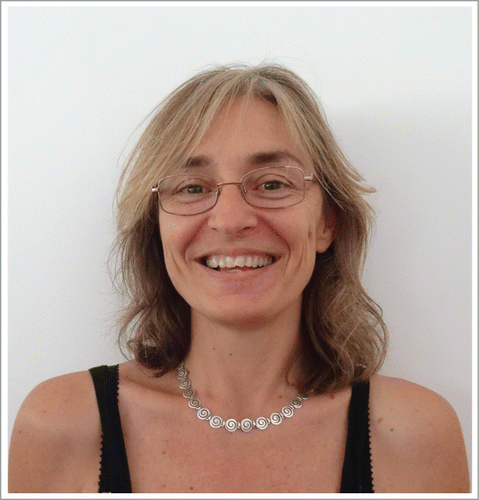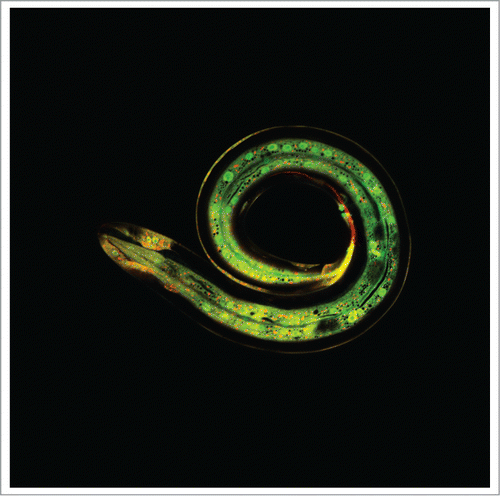How did you get interested in science?
Science was ever present at home. My father studied the inner ear. The beauty of the stereocilia of the cochlea, as seen in electron micrographs, arranged like choristers or the pipes in a church organ, always amazed me. I had his EM images on my wall since the age of 8. He's retired now, but still manages the educational site www.cochlea.org, where you can see some stunning pictures. This had an important influence, teaching me that aesthetics can be, indeed should be, part of science. It was one of the reasons that I subsequently chose to work with C. elegans: under the microscope, they really move gracefully.
What was your first position after university?
After I finished my PhD, having worked on axon guidance in C. elegans between Montpellier (France) and Gent (Belgium), I moved to work with Jean-Francois Brunet and Christo Goridis at the IBDM, a developmental biology institute on the Luminy science campus. My project was to study the C. elegans ortholog of a couple of vertebrate neuron-specific transcription factors, to explore phylogenetic aspects of neuronal identity and of its transcriptional determination. It was great to be in a lab doing comparative biology. And it is a magic site, on the outskirts of Marseille, in a national park, surrounded by pine trees, with paths winding down to the sea. This exceptional campus is one of the reasons I've stayed in Marseille; as well as the location, there's a lot of world-class science going on in multiple disciplines including biology, maths and physics. It's an ideal place to pursue interdisciplinary research.
How many people work in your lab?
The group currently has 12 people, several with permanent positions allowing us to embark on ambitious long-term projects. Nine nationalities are represented. In addition to French, we have students and post-docs from all over Europe and Asia. It makes for a wonderful atmosphere, with lots of cultural exchange; everyone loves Shizue Omi's informal sushi classes.
What areas or topics does your lab currently focus on?
Our general interest is the re-establishment of homeostasis after an infection, starting from how is the pathogen or damage detected to the communication between tissues to cope with the infection. We've chosen to study this using a natural fungal pathogen of nematodes. With C. elegans, we can address this at the molecular, cellular and organismal levels, and benefit from the remarkable resources that are available (). I still think unbiased genetic screens is the best way to start to address any biological question.
Do you have partners that are important for your research projects?
We've had a long-standing collaboration with Andrew Chisholm, who is now at UCSD. It's been great to put our complimentary interests and expertise together to explore the question of the degree to which the response to infection overlaps with that to physical injury. More recently, thanks to an on-campus network headed by Thomas Lecuit, funded by the French government for 8 years, we're interacting more and more with physicists and biophysicists, developing new optical methods and exploring mechanical aspects of infection.
Who were your mentors?
One of my first research experiences was with Alain Ghysen, who introduced me to developmental genetics in the fly. He taught me the importance of rigorous observation, and of having the capacity to see what is unexpected. I'm also indebted to Jean-Francois Brunet and Christo Goridis. They were able to give me the right level of guidance while leaving me complete liberty to run my project on C. elegans. Exploring the same question in 2 different organisms was extremely rewarding. And over the years, I've benefited from the advice and guidance of many different PIs in the worm community, including Cori Bargmann.
What are your research interests and your philosophy in scientific pursues?
An overarching notion is that there are so many interesting questions in biology that it is unnecessary to jump onto a subject just because it becomes popular; I don't like the idea of following trends just to try to get publications into high-impact journals.
What advice would you have to junior people entering the field?
All the familiar themes: see science as a vocation, not a career choice like banking or retailing. Follow your curiosity; look for the big questions. They'll be the hardest to solve but the most rewarding. Be rigorous. Don't be seduced into a technology-for-technology's sake approach. Lastly, for young women, don't underestimate the difficulties involved, given the entrenched attitudes. The recent supposedly light-hearted remarks of Sir Tim Hunt on the subject of women in labs reflect commonly held beliefs. And beyond this, combining research and having a family is an almost impossible task; you will never feel that you are giving enough to one or the other.
What do you think you would do if you were not an MD or a scientist?
I'd definitively like to be a musician; you need the same mixture of dedication, creativity, tenacity and aesthetics.
What do you do for fun?
Music. I sing in a choir and recently took up the recorder to be able to accompany my daughter who is learning to play the oboe. Her brothers play instruments and sing too. At times the house resembles The Sound of Music, apart from the fact that my husband is tone-deaf!
Figure 2. About Dr. Pujol. Nathalie Pujol received her graduate training at the Center de Recherche en Biochimie Macromoléculaire, Montpellier, France (1992-5), and the University of Gent, Belgium (1995-7). Since her PhD, she has worked in Marseille, France, first as a Postdoctoral fellow in the lab of Jean-Francois Brunet and Christo Goridis at the IBDM Developmental Biology Institute (1998-2001). She then got a tenured position in the group "Innate Immunity in C. elegans" at the Marseille-Luminy Immunology Institute (CIML), which she now co-directs with Jonathan Ewbank. She was a visiting researcher at UCSC, US (2001), and University of Oxford, UK (2008 and 2014). Dr. Pujol has authored >35 papers, book chapters and patents in diverse fields of Caenorhabditis elegans biology, including immunity, genetics and neurodevelopment, with highly cited seminal articles. Her current research focus is on the nematode's response to infection by the obligate fungal pathogen Drechmeria coniospora. She is a member of the National Review Board and Recruitment Committee at the CNRS, and the Virulence Editorial Board.


